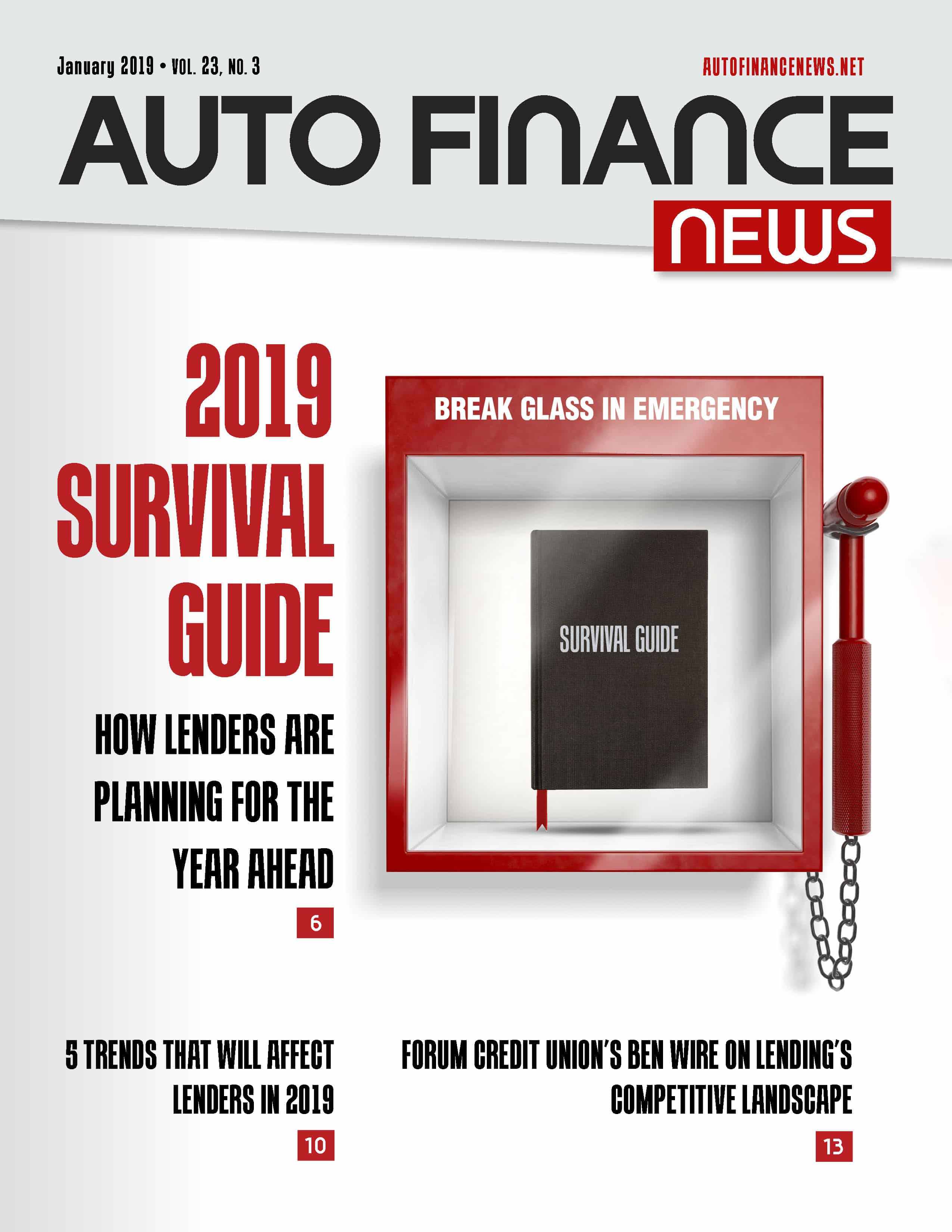
The January 2019 issue of Auto Finance News is now available.
From the January issue: The pace of U.S. growth is expected to slow, according to most economists, who also think interest rates will rise. There is uncertainty about tariffs and, beyond the economic factors, the race between different lenders, dealers, and manufacturers to overhaul products and services is picking up.
But perhaps the biggest challenge for auto finance execs will be slower car sales.
“We are expecting next year is going to be a softer year in terms of economic growth, but also in terms of vehicle sales and essentially all of the businesses related to that, which includes, of course, the finance side,” Cox Automotive Chief Economist Cox Jonathan Smoke told AFN.
If that’s the case, the auto finance industry will need to adapt in order to succeed.
“It’s easy enough to grow aggressively in an up market,” said Consumer Portfolio Service Chief Executive Charles Bradley. “It’s what happens in the downturn of the economy that’s going to show how well you’ve done.”
As the industry braces for what could be a bumpy ride, here’s a look at some of the key trends, in no particular order, that auto finance executives will be watching to succeed this year and in the years ahead.
1. Slower Vehicle Sales
The National Automobile Dealers Association forecasted in December 2018 that 16.8 million new cars and light trucks would be sold this year, a 1.1% drop year over year. Slowing car sales translate to higher competition among lenders, as the pool of originations shrinks.
That said, car shopping experts at Edmunds predict that auto sales will remain at a historically high level, despite the downward trend. Positive economic factors, including low unemployment, high consumer confidence, and low gas prices, will sustain the auto market in 2019.
2. Changing Preferences
Americans’ preference for SUVs and trucks are growing. Since these larger vehicles typically outprice sedans — SUVs and pickups have pushed the average price of a new vehicle to a record high of $37,000, according to an Edmunds report — lenders could see increased risk as buyers are willing to take on higher loan amounts with longer terms.
3. Higher Prices
Interest rates will create headwinds in 2019. The Federal Reserve last month boosted short-term interest rates a quarter-percentage point. While the Fed is unlikely to increase rates as often as it has in the past couple years, lenders, as well as analysts from Cox Auto and Moody’s Analytics put dealing with interest rates at the top of the lists for anticipated challenges this year.
New vehicles are $3,000 more expensive today than they were three years ago, according to Edmunds. And, with higher rates, buyers can expect to pay about $1,800 more in interest on a five-year loan than three years ago, Edmunds said.
“Obviously, affordability is a big issue we talk about in the industry and, as the interest rates increase, for especially new cars, it tends to slow [the industry] down,” said Chuck Jones, head of indirect lending at SunTrust Banks.
4. New Service Models
The Federal Reserve Bank of Chicago Senior Economist William Strauss begs the question: Are younger drivers going to be as enthusiastic about car ownership as previous generations? “It could be that this is a generation that just prefers to get car services and they won’t actually own vehicles,” he said.
Cash-strapped population groups, such as millennials, could find monthly subscription car services attractive. Lenders will need to figure out how they fit into subscription payment models. Also, younger drivers prefer to conduct business with their smartphones.
Changing models could lead lenders to enter into more partnerships with carfinancing apps like AutoGravity, which ended the year by doubling the number of its lender partners, to about 25. AutoGravity now has partnerships with BMO Harris Bank, Infiniti Financial Services, Nissan Motor Acceptance Corp., Santander Consumer USA, and TD Auto.
5. Tariffs
The wildcard of the new year will likely be tariffs. “It’s something we can’t control and likely won’t be resolved for a few months into the new year,” Cox’s Smoke said. Tariffs implemented on everything from steel to tires are pushing higher vehicle prices, fueling ongoing affordability issues.
“If we now see tariffs implemented that impact other countries or raise tariffs that are already in place, that could have an impact on the market,” he said.
Source : AutoFinanceNews










